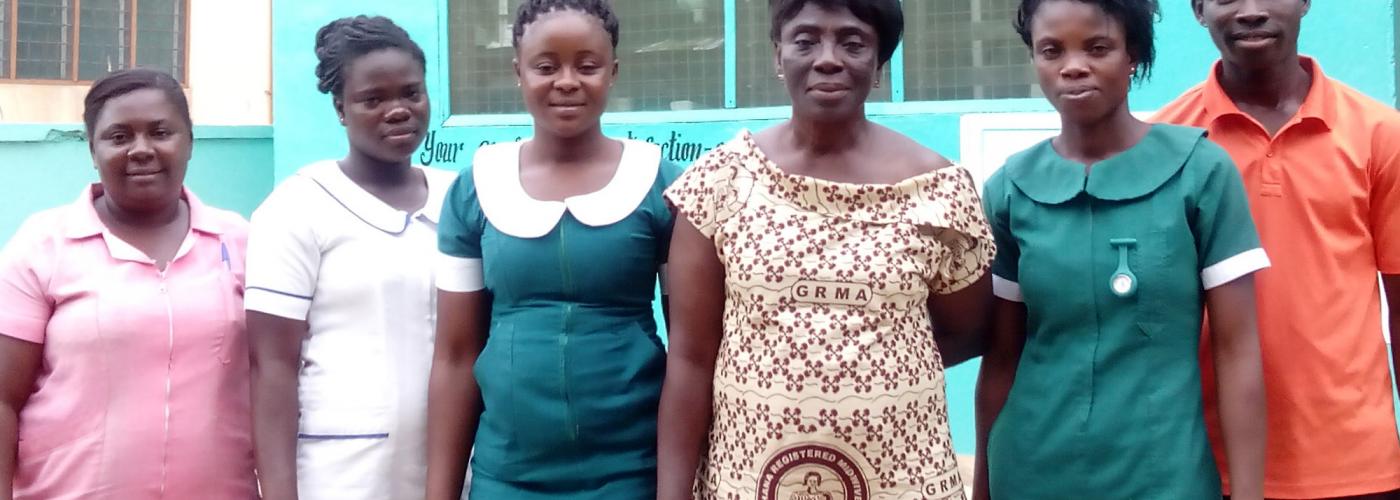Revitalizing Health Businesses: Strengthening Private Maternity Homes in Ghana
Image

The Problem
The USAID-funded Saving Maternity Homes (SMH) in Ghana project, led by Banyan Global in partnership with the Ghana Registered Midwives Association (GRMA) from 2014 – 2018, was designed to support a specific type of health provider: private maternity homes (PMHs). PMHs are private sector health businesses that specialize in delivering maternal, newborn and child health (MNCH) services, often in underserved and remote areas. Ninety percent of PMHs are owned by women, usually enterprising midwives who serve as both the main clinicians and the business managers. When the SMH project launched, these facilities were experiencing a persistent attrition. GRMA estimated that more than 100 PMHs closed across the country between 2008 – 2013, with many more operating at reduced capacity.
The Context
In designing the SMH project, GRMA identified several interrelated explanations for these closures, which were soon confirmed by the baseline assessment. The reliance on a single midwife-owner was indeed creating a risk to business continuity – if an ageing midwife fails to do meaningful continuity planning, then her retirement or death often means that the facility closes. The average age of PMH owners in Ghana was 65, against the national retirement age of 60. Additionally, less than half of the facilities interviewed at baseline (48 percent) had a succession plan in place, and even fewer (45 percent) could name the person who would take over if the owner died or retired.
There were also questions about the quality of PMHs’ clinical service delivery and business practices. At baseline, half of the responding PMHs failed to achieve a passing score on GRMA’s clinical quality assessment. Clinical health care is the PMH’s core service, meaning that issues of quality are problems for business success and continuity. There was also room for improvement on the business management side, with one-third of PMHs keeping no financial documents, and 44 percent unable to provide even an estimate of monthly profits. Additionally, interest rates for small and medium enterprise (SME) lending in Ghana were hovering around 32-35 percent, high even for Sub-Saharan Africa. These high interest rates meant that even stellar PMHs were unable to secure the needed capital to finance expansion or improvement.
Finally, in 2003 Ghana launched an ambitious national health insurance initiative, one that covered 40 percent of the population by 2014. But this success came with challenges, including delays in reimbursements to providers that created significant cash flow problems. At project baseline, 83 percent of PMHs reported an average delay of six months or longer. On top of the delays, at the time of the project the National Health Insurance Scheme (NHIS) was planning a major structural shift from a reimbursement to a capitation payment model that would require patients to select a preferred provider for their care. In Ghana PMHs were legally restricted to serving pregnant women, new mothers, and children under five, and so would not be attractive to families looking to select a preferred primary provider that could meet all of their family’s health needs. Thus, PMHs faced the choice of adding services (and other clinicians) and transitioning into a full clinic or closing.
The Solution(s)
The SMH project designed a package of interventions to tackle the challenges facing the survival of the PMH sector, with a specific facilitative innovation focused on addressing the over-reliance on a single critical individual. In thinking through strategies for enhancing continuity, we identified four types of structural “transformation” that would enable the facility to survive the exit of the primary midwife-owner: 1) the PMH is legally sold to a new owner (sale); 2) the facility is leased to a new manager/operator (lease); 3) the current owner brings on a new partner who has both an ownership stake and a management role (partnership); and 4) the current owner appoints a manager who has authority over facility management (management contract). During the project we added a fifth: a service diversification contract, which occurred when the PMH added a skilled clinician who enabled the PMH to expand its range of services.
Additionally, we provided business training and coaching, clinical training and supportive supervision, and limited grant financing ($5,000 per recipient) to improve quality and expand service delivery. Much of this assistance was offered to all PMHs in six target regions in Ghana, though the facilities that elected to go through one of the five “transformations” got extra coaching and were the only ones eligible to receive grants. We also provided organizational capacity strengthening for GRMA, our local partner, and conducted operations research to understand the effectiveness of the project model.
The Results
As a pilot project, we set a target of 20 transformations and achieved 22, including 14 management contracts, 7 service diversification contracts, and 1 sale. In addition to these 22 facilities, the endline assessment included 77 non-transformed facilities, which had received some technical assistance focused on business and clinical strengthening. Overall the results were encouraging:
- 88 percent of PMHs – including 87 percent of non-transformed and 95 percent of transformed PMHs – demonstrated an improvement in financial sustainability.
- 92 percent of PMHs – including 90 percent of non-transformed and 100 percent of transformed PMHs – demonstrated an improvement in the quality of clinical services.
- Non-transformed facilities experienced a 21 percent increase in MNCH visits, while transformed facilities experienced a 51 percent increase.
- 65 percent of transformed facilities expanded, adding new health services or increased capacity, while 46 percent of transformed facilities transitioned into a health center or clinic (which is capable of offering a broader range of services).
- While the proportion of non-transformed PMHs that were managed by the owner decreased by only one percent, the proportion of owner-managed transformed PMHs decreased by 44 percent (one of the goals of the project).
There were also disappointments. We would have preferred a wider variety of transformation types, including partnerships and leases; however, we discovered that many PMH owners were initially reluctant to make such a drastic change. Additionally, we were not able to make a dent in the access to finance problem, despite efforts to work with a variety of lending institutions. And, we were not able to push the average age of new personnel – 50 years old – down as far as we would have liked.
The So-What?
In addition to the improvements in clinical quality, increases in financial sustainability and expansion of MNCH services, the SMH project produced several interesting findings related to inclusive market development. First, one of the main constraints on PMH continuity and expansion was staffing, rather than the usual market development suspects like access to finance or access to markets. By brokering the acquisition of needed personnel, so critical to the functioning of this type of highly specialized service business, the project facilitated the management continuity needed to survive the departure of the key midwife-owner.
Second, PMHs (and private health providers generally) occupy an unusual category of often being financially viable yet carrying enormous room for improvement, both in their core business (delivery of health services) and in the quality of their business management. This baseline dynamic made technical assistance particularly impactful.
Third, the SMH project occurred amidst a massive shift in the enabling environment for PMHs. Delays in reimbursement, and the planned transition from a reimbursement to a capitation system, created strong incentives for the PMHs to enact changes that would allow them to survive these shifts.


